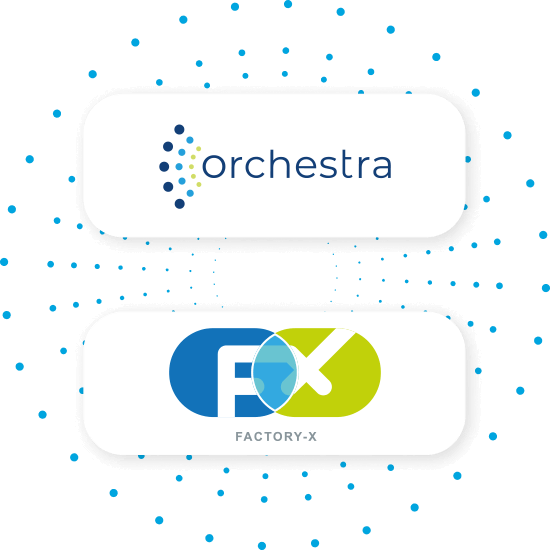Factory-X
Orchestra as a multidirectional data integration platform

If industrial companies want to optimise their processes, increase their competitiveness or promote their resilience, they cannot avoid one thing: they must ensure the data connectivity of their machines and systems. This also applies if companies want to utilise digital innovations or expand their business field with digital offerings. After all, an appropriate database creates the basis for all of these aspects.
However, it is not enough if the collected data is only available and utilised within the company. The data must also be accessible to external parties. For this data exchange, so-called data spacess or data ecosystems must be created.
In order to design these data spaces and ecosystems for industry, the consortium project Factory-X was initiated, in which soffico is involved as an expert in data integration and interoperable connectivity is involved.
Podcast on the flagship project Factory-X
Enable data integration between IT systems and machines with Orchestra

About the project:
What exactly is Factory-X?
Factory-X is a large consortium project that started in February 2024 with a total of 47 network partners and ten associated partners. It is the flagship project within the Manufacturing-X initiative, which is funded by the Federal Ministry for Economic Affairs and Climate Protection. The aim of the project is to design data spaces and data ecosystems for industry in which data from the shop floors of manufacturing companies can be made interoperable and securely accessible.
The consortium aims to develop architectures and standards that can then be implemented into interoperable solutions. To this end, each consortium partner brings in its own experience and know-how from projects that have already been implemented. The focus is on factory operators, factory suppliers and their suppliers.

soffico’s role in Factory-X:
Data integration expert
soffico brings its experience from over 12 years of data integration in various industries. The Orchestra software developed by soffico enables basic data integration to make company data usable. In addition, the results and findings, which are implemented by soffico in the project, among others, will be transferred to Orchestra after the end of the project.
The Uhlmann Group is also represented in the consortium. The packaging machine manufacturer is already working with soffico outside of the consortium project to improve connectivity in production and develop new digital business models.
Since the Uhlmann Group operates as a manufacturer of packaging systems for pharmaceuticals, the focus of the joint collaboration within the Factory-X project in the “Modular Production” subproject is, among other things, on ensuring scalable and interoperable connectivity. This is a relevant aspect in this industry, especially given the high demands on traceability and documentation.
In addition, the two companies are working on concepts in the context of change processes in production, for which interoperable connectivity forms the basis.
The concepts developed can later be transferred as solutions to the challenges faced by machine and plant manufacturers in less strictly regulated markets.
In addition to the “Modular Production” subproject mentioned, soffico is involved in the “Manufacturing as a Service” and “Kernel & Basic Services” subprojects.
The challenge: Creating a scalable and standardized connectivity basis for the entire production landscape
In soffico’s collaboration with the Uhlmann Group so far, an important insight has emerged: It is not enough for technical skills in the area of data or digital products to be developed in a company alone. For example, customers who use packaging machines from the Uhlmann Group require monitoring of the entire line for their condition monitoring. This also includes the steps that are not carried out by the Uhlmann Group machines.
In other words: The individual machine and plant manufacturer and their machines are always just a small component in the overall system of a shop floor. However, it is not enough to just network the machines horizontally on the shop floor. The data from all individual assets must be available at scalable standards so that it can be used vertically throughout the supply chain and in factories worldwide – regardless of how many different assets are in use.
For this reason, soffico is participating in the “Kernel & Basic Services” sub-project as part of the Factory-X project. Common technical foundations and architectures are defined and developed here. This enables horizontal and vertical connectivity, ensures the operation of the data ecosystem and thus ensures interoperability between the various partners, components, etc. These standards also make it simpler and more uniform access to the Factory-X data space created.
The approach: Orchestra as a data integration tool
A central point in the context of Factory X is to enable standardized and secure data exchange between companies along the value chain.
The low-code data integration platform Orchestra from soffico can be used for this: The platform is able to aggregate data from a wide variety of sources, regardless of protocol and format, and make it available for further processing. This is an enormous relief, especially given the heterogeneity of existing systems and their interfaces and data formats. On the platform itself, the data can be integrated both graphically and code-based. In addition, the data can be easily mapped with regard to its source and target system-dependent structures.
The data exchange between the systems as well as the data mapping can be done live with Orchestra.
Operation can be monitored.
For example, Uhlmann uses exactly this tool to create integration between its own systems and customer systems.
Orchestra also makes it easier to connect to existing legacy systems because the data is still stored in these systems. Orchestra makes this data available and thus meets (future) interoperability requirements without having to replace or replace systems. Also in this context, Orchestra offers great added value through the integration and transformation of the data.
The goal: ensure interoperability and maintain data sovereignty
What seems difficult to reconcile at first glance is the consortium’s overarching goal: maintaining data sovereignty while maintaining a high level of data interoperability. In order for different companies to make their data available, it must be ensured that they maintain control over who has access to which information.
The approach is to make it transparent to the outside world what data is available and what offers can be made to the market. At the same time, a solution should be created to determine through contractual agreements who has access to this data. This means the company always retains control over who the data is passed on to. In addition, the data can be monetized if necessary and its exchange can be ensured in a standardized format. The three main components are: the catalog of what is available; the contract about who can access it; and the actual data transfer.
Orchestra and solutions from competitors have already laid the foundations for this. The future lies in the development of solutions that can be reused hundreds or thousands of times.
This is already easily feasible within a company: developing a shop floor connection and rolling it out to 50 plants worldwide is no problem. The next step is to implement this across companies and industries to achieve a high level of reusability.
Note
The Factory-X project will run until July 2026. After that, the core modules and services developed as part of the funded project (basic services, shared services, etc.) will be combined into Factory-X basic services and made available to the public as part of an open source strategy made available.
Markus Benndorff
